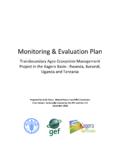Transcription of WHAT IS AGROBIODIVERSITY?
1 WHAT IS agrobiodiversity ? agrobiodiversity is the result of natural selection processes and the careful selection and inventive developments of farmers, herders and fishers over millennia. agrobiodiversity is a vital sub-set of biodiversity. Many people's food and livelihood security depend on the sustained management of various biological resources that are important for food and agriculture. Agricultural biodiversity, also known as agrobiodiversity or the genetic resources for food and agriculture, includes: Harvested crop varieties, livestock breeds, fish species and non domesticated (wild) resources within field, forest, rangeland including tree products, wild animals hunted for food and in aquatic ecosystems ( wild fish).
2 Non-harvested species in production ecosystems that support food provision, including soil micro-biota, pollinators and other insects such as bees, butterflies, earthworms, greenflies; and Non-harvested species in the wider environment that support food production ecosystems (agricultural, pastoral, forest and aquatic ecosystems). [Box 1] agrobiodiversity IS CENTRAL TO OVERALL BIODIVERSITY. Mixed agro-ecosystems BIODIVERSITY Crop species/varieties Livestock and fish species Plant/animal germplasm Soil organisms in cultivated areas Biocontrol agents for crop/livestock pests agrobiodiversity Wild species as landraces or with breeding Cultural & local knowledge of diversity agrobiodiversity is the result of the interaction between the environment, genetic resources and management systems and practices used by culturally diverse peoples.
3 And therefore land and water resources are used for production in different ways. Thus, agrobiodiversity encompasses the variety and variability of animals, plants and micro-organisms that are necessary for sustaining key functions of the agro-ecosystem, including its structure and processes for, and in support of, food production and food security (FAO, 1999a). Local knowledge and culture can therefore be considered as integral parts of agrobiodiversity , because it is the human activity of agriculture that shapes and conserves this biodiversity.
4 WHAT IS agrobiodiversity ? Source: FAO, 1999a [Box 2] A DEFINITION OF agrobiodiversity . The variety and variability of animals, plants and micro-organisms that are used directly or indirectly for food and agriculture, including crops, livestock, forestry and fisheries. It comprises the diversity of genetic resources (varieties, breeds) and species used for food, fodder, fibre, fuel and pharmaceuticals. It also includes the diversity of non-harvested species that support production (soil micro-organisms, predators, pollinators), and those in the wider environment that support agro-ecosystems (agricultural, pastoral, forest and aquatic) as well as the diversity of the agro-ecosystems.
5 Many farmers, especially those in environments where high-yield crop and livestock varieties do not prosper, rely on a wide range of crop and livestock types. This helps them maintain their livelihood in the face of pathogen infestation, uncertain rainfall and fluctuation in the price of cash crops, socio-political disruption and the unpredictable availability of agro-chemicals. So-called minor or underutilized crops, more accurately, companion crops, are frequently found next to the main staple or cash crops.
6 They often grow side by side and their importance is often misjudged. In many cases, from a livelihoods perspective, they are not minor or underutilized as they can play a disproportionately important role in food production systems at the local level. Plants that will grow in infertile or eroded soils, and livestock that will eat degraded vegetation, are often crucial to household nutritional strategies. In addition, rural communities, and the urban markets with which they trade, make great use of these companion crop species.
7 [Box 3] COLLECTION OF WILD PLANTS FOR HOUSEHOLD CONSUMPTION. In Burkina Faso, and throughout the West African Sahel, rural women carefully collect the fruit, leaves and roots of native plants such as the baobab tree (Adansonia digitata), red sorrel leaves (Hibiscus saddarifa), kapok leaves (Ceiba pentandra) and tigernut tubers (Cyperus esculentus L.) for use in the families' diet. These supplement the agricultural grains (millet, sorghum) that provide only one part of the nutritional spectrum and may fail in any given year.
8 More than 800 species of edible wild plants have been catalogued across the Sahel. Source: IK Notes No. 23. 2000. There are several distinctive features of agrobiodiversity , compared to other components of biodiversity: agrobiodiversity is actively managed by male and female farmers;. many components of agrobiodiversity would not survive without this human interference; local knowledge and culture are integral parts of agrobiodiversity management;. many economically important agricultural systems are based on alien' crop or livestock species introduced from elsewhere (for example, horticultural production systems or Friesian cows in Africa).
9 This creates a high degree of interdependence between countries for the genetic resources on which our food systems are based;. as regards crop diversity, diversity within species is at least as important as diversity between species;. because of the degree of human management, conservation of agrobiodiversity in production systems is inherently linked to sustainable use preservation through establishing protected areas is less relevant; and in industrial-type agricultural systems, much crop diversity is now held ex situ in gene banks or breeders'.
10 Materials rather than on-farm. WHAT IS agrobiodiversity ? An overview of the key roles of agrobiodiversity is provided in the following Box. Not all the roles listed will be relevant in any given situation. Nonetheless, this list may serve as a checklist to prioritize those that are crucial in a project/work situation. (Adapted from Thrupp, 1997). [Box 4] THE ROLE OF agrobiodiversity . Experience and research have shown that agrobiodiversity can: * Increase productivity, food security, and economic returns * Reduce the pressure of agriculture on fragile areas, forests and endangered species * Make farming systems more stable, robust.











